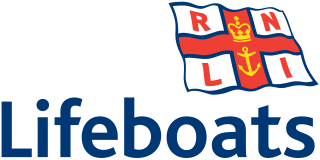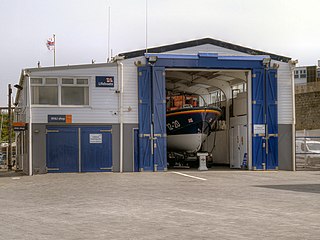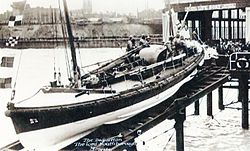
The Royal National Lifeboat Institution (RNLI) is the largest of the lifeboat services operating around the coasts of the United Kingdom, the Republic of Ireland, the Channel Islands, and the Isle of Man, as well as on some inland waterways.

Walmer Lifeboat Station is located on The Strand on Walmer promenade, in the county of Kent.
RNLB Guide of Dunkirk is a 35ft 6in Self-righting motor-class lifeboat whose construction was funded by the Girl Guides in 1940. She was self-righting and designed for launching from a beach. As one of the Little Ships of Dunkirk she was used in the evacuation of Allied soldiers from Dunkirk in World War II. Between 1941 and 1963 she was stationed in Cadgwith, UK as a lifeboat. In 1963 she passed into private ownership.
Margate was a "limb" of Dover in the ancient confederation of the Cinque ports. It was added to the confederation in the 15th century.

The Little Ships of Dunkirk were about 850 private boats that sailed from Ramsgate in England to Dunkirk in northern France between 26 May and 4 June 1940 as part of Operation Dynamo, helping to rescue more than 336,000 British, French, and other Allied soldiers who were trapped on the beaches at Dunkirk during the Second World War.

Ramsgate Lifeboat Station is a Royal National Lifeboat Institution (RNLI) station located in the Port of Ramsgate in the English county of Kent. The station is one of the oldest to operate in the British Isles and has launched to many notable services. Among the awards won by its crews over the years are 42 RNLI medals, including 2 gold, 39 silver and 1 bronze, the last being awarded in 2000.

Southwold Lifeboat Station is an RNLI operated lifeboat station located in the town of Southwold in the English county of Suffolk.

Newhaven Lifeboat Station is an RNLI station located in the town of Newhaven in the English county of East Sussex in the United Kingdom. The original station was established in 1803 and taken over by the RNLI in 1854.

Lowestoft Lifeboat Station is a Royal National Lifeboat Institution (RNLI) operated lifeboat station in the town of Lowestoft in the English county of Suffolk. The station is located at the mouth of Lowestoft's outer harbour on the South pier. It is one of the oldest lifeboat stations in the United Kingdom, having been established in 1801.

RNLB Lucy Lavers was an RNLI lifeboat which was on No. 2 station at Aldeburgh from 1940 until 1959 when she was placed in the reserve fleet until 1968 when she was retired. The Rescue Wooden Boats Charity is currently undertaking restoration of the vessel. The Lucy Lavers is entered in the National Historic Ships register and has the Certificate No 2206.

Margate Lifeboat Station is a Royal National Lifeboat Institution (RNLI) station located in Margate in the English county of Kent. The station is over 160 years old. Its crews have earned a number of gallantry awards, including five silver and 1 bronze RNLI medals for bravery.
Sheerness Lifeboat Station is an Royal National Lifeboat Institution (RNLI) station located in the town of Sheerness on the Isle of Sheppey in the English county of Kent. The station is on the north coast of the county, strategically placed at Garrison Point at the mouth of the River Medway and close the busy Thames estuary. The RNLI first stationed a lifeboat here in 1969.

Dover Lifeboat Station is a Royal National Lifeboat Institution (RNLI) lifeboat station located in the town of Dover in the English county of Kent. The station first opened in 1837, coming under the RNLI’s control in 1855.

Walton and Frinton Lifeboat Station is a Royal National Lifeboat Institution (RNLI) station located in the town of Walton-on-the-Naze in the English county of Essex.

Selsey Lifeboat Station is a Royal National Lifeboat Institution (RNLI) station located in Selsey, West Sussex on the south coast of England.

Shoreham Harbour Lifeboat Station is a Royal National Lifeboat Institution (RNLI) station located in the town of Shoreham-by-Sea in the English county of West Sussex.
A number of awards have been established by the Royal National Lifeboat Institution (RNLI) since its creation in 1824. None are approved by the Crown, and are therefore unofficial awards. As such, they do not appear in the official British order of wear, although the principal lifesaving award, the Medal of the RNLI, can be worn on the right breast in uniform by members of the British armed forces.

The Margate Jetty was a pier in Margate, Kent, in England initially constructed of wood in 1824. It was rebuilt in iron in 1855 and extended and added to over the years. It closed in 1976 over safety concerns and was severely damaged in a storm two years later. Demolition took many years and some parts remained until 1998.

Clacton-on-Sea Lifeboat Station is located on Hastings Avenue, in the seaside town of Clacton-on-Sea, on the Tendring peninsular, in the county of Essex.

Hythe Lifeboat Station was located at the eastern end of West Parade, in the market town of Hythe, which is situated 7 miles (11 km) west of Folkestone, on the Kent coast.
















